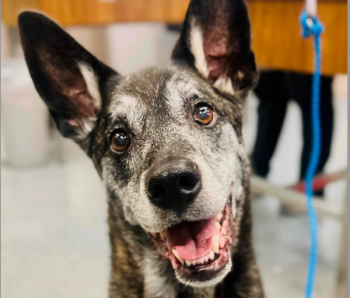
Mast cell tumors in dogs and cats (Proceedings)
Mast cells are normal inflammatory cells that are produced in the bone marrow and mature in connective or mucosal tissues.
Please be aware that these notes are not designed to be a complete reference. It is advisable to consult with an oncologist for current treatment recommendations prior to developing a therapeutic plan for your patient.
Normal Mast Cell Biology and Effects of Degranulation
Mast cells are normal inflammatory cells that are produced in the bone marrow and mature in connective or mucosal tissues. Connective tissue and mucosal mast cells are different populations of cells. Mast cells are normally found in the skin, GI tract, respiratory tract, and conjunctiva. They are round cells that contain metachromatic (purple staining with Wright's stains) granules. The surface of the mast cell has high affinity receptors for the Fc portion of IgE; consequently, the surfaces of mast cells are covered with IgE. Upon allergen binding of 2 or more IgE antibodies, the mast cell is activated and releases its granules (degranulation).
The cytoplasmic granules in mast cells contain biologically active amines including histamine, heparin, eosinophil chemotactic factor, leukotrienes, prostaglandins, and other cytokines. Release of these bioactive chemicals (in particular histamine) leads to inflammation, vasodilation, increased vascular permeability, stimulation of nerve endings (to cause itching or pain), and increased gastric HCl production (via gastric H2 receptors). Clinically with mast cell tumors we can see wheal formation/swelling, inflammation, hypersensitivity reactions, GI ulceration, vomiting, diarrhea, lethargy, or loss of appetite, coagulopathy (due to heparin), and/or decreased wound healing (due to stimulation of macrophages to produce a fibroblast suppressor factor).
Canine Mast Cell Tumors
Incidence and Signalment
Mast cell tumors (MCT) are the most common skin tumor of the dog. They represent about 20% of all skin tumors. MCT typically affect older dogs (average of 9 years), but can be seen in any age dog. MCT affect any breed, but boxers, pugs, Boston terriers, bulldogs, bull terriers, and retrievers have been reported to be predisposed. Mast cell disease can occur as a visceral form, but this is rare. Visceral involvement usually represents systemic spread from a primary cutaneous MCT. Primary intestinal MCT is also rare in dogs.
History and Presentation
Typically a dermal or subcutaneous mass is noted. MCT can occur anywhere on the body. Approximately 50% occur on the trunk, 40% on limbs, and 10% on the head. MCTs are often incidental findings on routine examinations. Owners may note a mass/masses. 10-15% of dogs present with multiple mast cell tumors. There may be a history of recurrent swelling (due to degranulation and release of histamine). Bruising (due to release of heparin) may also be seen at the site of a MCT. The mast cells in MCTs have 25-50X the level of histamine of normal mast cells. With systemic disease or large bulky tumors, gi signs, melena, abdominal pain, and lethargy may be seen secondary to high circulating levels of histamine. GI ulcers have been reported in 35-83% of dogs with MCT at necropsy. Occasionally, owners will report that a mass that has been present and slow growing has changed and is now growing more rapidly.
Well to moderately differentiated tumors tend to be solitary, slow growing, and firm to fluctuant in texture.
Poorly differentiated tumors may have more aggressive histories, with rapid growth, potentially with intermittent tumor swelling and pain.
Biologic Behavior
MCT have variable behavior that can range from benign to highly aggressive, both locally invasive and highly metastatic. Metastatic MCT spread through lymphatics to local lymph nodes then to spleen and liver. Metastatic mast cells may also be seen in the blood and bone marrow. They also can spread in dermal lymphatics, resulting in "skip metastasis" (a new MCT in the region of the original MCT). Different from other tumors, it is very unusual for MCT to spread to the lungs. Invasiveness and metastatic rate is related to tumor grade. Grade I MCT should not metastasize. 5-15% of grade II MCT will metastasize. Grade III MCT have been reported to have a metastatic rate of 55-96%.
Prognostic Indicators
1. Tumor grade→most important
2. Metastasis (lymph nodes, liver, spleen, and/or bone marrow) associated with poorer prognosis
3. Location - mucocutaneous junctions, digital, aural, muzzle, inguinal, perineal, scrotal, viscera, and GI tract may be more aggressive locally and systemically.
4. Breed - brachycephalic breeds (e.g. Boxers, pugs, etc) have been shown to have more low grade MCT, but can still develop high grade MCTs.
5. Growth rate - recent, rapid growth associated with poor prognosis
6. Clinical appearance - ulcerated, inflamed mass, clinical signs of degranulation = more aggressive MCT. Small masses present for 1+ years may be less aggressive.
Diagnosis and Staging
1. Physical examination - MCTs are great imitators and can look like anything from a dermal mass to wrinkly skin to a soft subcutaneous mass (like a lipoma) to a firm bruised or ulcerated mass. It is important to examine patients closely for masses. Darier's sign is wheal and flare formation at the site of MCT. This is suggestive for MCT, but the bottom line is really that all masses should be aspirated. Measure all masses and document in medical record with dog diagram or photo. It is important to palpate local lymph nodes and the abdomen (for hepatomegaly and splenomegaly) as well. Note that manipulation of a MCT can stimulate degranulation.
2. Minimum data base before surgery
a. CBC, chemistry profile, urinalysis - Mainly to evaluate overall health. Rarely will see circulating mast cells or eosinphilia.
b. Fine needle aspiration and cytology of mass and local lymph node MCT exfoliate well. This will usually be diagnostic (exception: poorly granulated high grade MCT). It is important to aspirate the local lymph node before surgical resection. If the node is positive or inconclusive (some mast cells seen, not sure if metastatic), resection and submission of the node at the time of resection of the primary tumor is recommended. MCTs are not graded based on cytology, histopathology is required for grading. Aspiration of a MCT can stimulate degranulation and that MCTs often bleed after FNA due to heparin in mast cells.
The need for further staging tests will be determined by grade, evidence of spread to lymph node, and other prognostic indicators. All dogs with grade III MCT and dogs with grade II MCT and negative prognostic indicators should be fully staged.
3. Imaging
a. Thoracic radiographs – Not always indicated because mast cell tumors typically do not spread to the lung. Can use to assess sternal lymph node or to evaluate for other intrathoracic disease (e.g. primary lung tumor, cardiomegaly, etc.) prior to therapy.
b. Abdominal imaging - Liver/spleen may appear normal even if affected by MCT, but look for hepatomegaly, splenomegaly, nodular pattern on ultrasound or diffuse infiltrative pattern. Lymphadenomegaly may also be noted.
4. Bone marrow aspirate - No longer performed routinely due to low incidence of MCT in the marrow (~4%).
5. Buffy coat smear - No longer performed because non-specific and insensitive. Dogs with inflammatory or allergic diseases have highest numbers of mast cells in the buffy coat.
6. Biopsy and histopathology
a. Excisional biopsy preferred unless diagnosis is unclear (usually diagnosis possible with cytology).
b. For anaplastic tumors with few granules special stains will help with diagnosis (Giemsa, Toluidine Blue).
c. Margins (if excisional biopsy) – would like 1 cm margins around tumor on histopathologic exam
d. Vascular/lymphatic invasion – if present, tumor has started to metastasize
e. Histologic grade – considers degree of differentiation, mitotic index, degree of granulation, invasion into underlying tissue. The Patnaik grading system for MCT is the system used in North America: grade I=well differentiated, grade II=moderately differentiated, grade III=poorly differentiated. There is variation among pathologists in assigning grade.
f. Molecular markers and proliferative indices including AgNOR, PCNA, Ki-67, and c-kit may provide additional prognostic information. To date none have been shown to be better indicators than grade. We use this information in conjunction with grade and possibly to help identify more aggressive grade II MCTs. Recent studies have shown that mutations in c-kit (a gene coding a receptor tyrosine kinase) have been associated with higher grade MCTs and the immunohistochemical staining pattern for c-kit in MCTs is associated with prognosis (Kuipel et al. 2006). The c-kit staining patterns were:
I = cytoplasmic membrane
II = intense focal cytoplasmic or stippling throughout cytoplasm
III = diffuse cytoplasmic staining obscuring all other cytoplasmic features
Patterns II and III were associated with greater risk of recurrence and death due to MCT
Treatment
1. Surgery – this is the treatment of choice for all MCTs unless impossible to remove. It is recommended that 2-3 cm and an intact fascial plane deep to the tumor be removed when resecting a MCT. It is helpful to paint the margins with the Davidson Marking System to help the pathologist identify the margins, especially any margins of concern.
Surgery is curative for most grade I and grade II MCTs. The local recurrence rate for completely excised grade II MCTs has been reported to be 5-11%. Further therapy is indicated for incompletely excised MCT, all grade III MCT, and grade II MCT with negative prognostic indicators.
For incompletely excised MCT, if enough tissue is present to allow a second surgery with 2-3 cm margins around the scar and a fascial plane deep to the scar, re-excision is recommended.
2. Radiation Therapy (RT) - MCTs are very sensitive to radiotherapy. Used for local therapy of MCT that have been incompletely excised (i.e. microscopic disease remaining) from areas where a second surgery is impossible due to location or size of scar. RT works best in the setting of microscopic disease. For incompletely excised grade II MCTs with no evidence of metastasis, one and 2-5 year local control rates with RT are 94-97% and 85-93%, respectively. For bulky disease (i.e. nonresectable tumors), RT provides ~50% control at one year; usually not curative. There is some risk of degranulation post-RT of large MCTs. Side effects depend on location (see RT lecture).
3. Chemotherapy - Indicated for all grade III MCTs and for grade II MCTs that have metastasized or have negative prognostic indicators (for example: location associated with metastatic behavior, vascular/lymphatic invasion). May also be used for gross non-resectable disease or for incompletely excised MCT if RT not an option. Multiple drugs have been used for MCT: prednisone (20% response rate, 70% short term?), vinblastine (12% response rate? 47% when combined with prednisone), CCNU (42% response rate), cyclophosphamide (combined with vinblastine and prednisone 64%). 3-6 month combination protocols that incorporate vinblastine, prednisone, +/- an alkylating agent (CCNU or cyclophosphamide) are used adjunctively. If gross disease is present, chemotherapy is continued as long as effective and side effects not prohibitive. Chemotherapy works best in the setting of microscopic disease. With these protocols median survival times for dogs with grade III MCT has been improved to 11 months to >3.5 years and even better for ""high-risk" grade II MCT.
4. Symptomatic therapy – is employed to manage the effects of histamine release from MCT. H1 receptor antagonists (usually diphenhydramine 2 mg/kg q8hours) are used to decrease inflammation, swelling, vasodilation, capillary leakage and prevent hypotension and shock. H2 antagonists (usually famotidine 0.5-1 mg/kg q12-24 hours) are used to block histamine stimulation of gastric acid secretion. For clinical GI ulceration (e.g. melena), may need to add sucralfate and/or omeprazole.
Feline Mast Cell Tumors
Incidence and Signalment
MCT are the second most common skin tumor in cats, representing 12-20% of all reported skin tumors.
Affects older cats (average of 9 years); no breed or sex predilection. Visceral MCTs are more common in the cat with up to 50% occurring in visceral locations. A splenic form is recognized in cats that is the most common cause of splenomegaly in cats. Intestinal MCT is the 3rd most common intestinal tumor in cats.
History and Presentation
MCT in cats most commonly presents as small, solitary, raised, well-circumscribed hairless nodules, often white or pink. May also be flat, plaque like, sometimes ulcerated lesions. 51% MCT in cats are located on the head. 15-20% of cats present with multiple masses. They can be multiple distinct masses or miliary. Cats with visceral mast cell tumor present for lethargy, loss of appetite, weight loss, weakness, dyspnea/tachypnea, vomiting, and diarrhea.
Biologic Behavior
Must cutaneous MCT in cats are benign in behavior. Rarely, cutaneous MCTs in cats will be more invasive and metastasize to lymph nodes, spleen, liver, blood, or bone marrow. Splenic and intestinal MCT are highly metastatic and will spread to liver, lymph nodes, bone marrow, and lung. Splenic MCT can spread to intestine. Despite this, cats with splenic MCT, even with widespread dissemination, can enjoy remission and long term survival following splenectomy! Intestinal MCT appears to be associated with a poorer prognosis.
Diagnosis and Staging
1. Physical examination – Look for additional masses, palpate regional lymph nodes. Splenomegaly is usually obvious in cats with splenic MCT and cats with intestinal MCT often have a palpable abdominal mass(es), weight loss. Peritoneal or pleural effusion may be present with disseminated disease. Dyspnea/tachypnea may be seen in cats with disseminated disease due to degranulation, anemia, or pleural effusion.
2. CBC, chemistry panel, urinalysis – usually normal for cats with cutaneous MCT, but cats with visceral mast cell disease are commonly anemic. Cats with splenic MCT frequently have circulating mast cells. Eosinophilia is possible.
3. Fine needle aspirate and cytology - mass and regional lymph for cutaneous MCT. Usually diagnostic, but may be confused with eosinophilic granuloma. Lymph node will usually be negative, but if positive, further staging should be pursued. For visceral MCT, ultrasound-guided aspirate and cytology will frequently be diagnostic.
4. Thoracic and abdominal imaging, bone marrow aspirate, and buffy coat smear – Not typically performed for cats with cutaneous MCT unless metastasis or systemic disease is suspected due to unusual presentation, multiple masses, lymph node involvement, splenomegaly, or clinical signs. In cats with visceral MCT, organomegaly, lymphadenomegaly, and effusion may be seen. Diffuse gi involvement is possible with the intestinal form. Bone marrow aspirate is more sensitive for MCT, but buffy coat smear is easier to perform and may be useful for monitoring systemic disease (especially after splenectomy in cats with splenic MCT).
5. Biopsy and histopathology – typically, excisional biopsy is performed because diagnosis is made with cytology. Histologic grading has not been useful prognostically in cats.
Treatment and Prognosis
1. Surgery – for cutaneous MCT conservative surgery is usually curative (0-24% recurrence rate, cats do not usually die of MCT) and narrow margins are acceptable. With splenectomy the average survival for cats with splenic MCT is 12-19 months. For intestinal MCT, resection and anastamosis with removal of 5-10 cm of normal intestine on either side is needed for the mass lesion. Metastasis is still likely.
2. Radiation therapy – if MCT is in a bad location or cannot be excised, RT is an option. Strontium-90 resulted in tumor control in 98% of superficial MCT for a median of 783 days. This is a single treatment and only penetrates 2-3 mm – good for eyelids, pinnae, face.
3. Chemotherapy - recommended for metastatic MCT, gi MCT, splenic (if doesn't go into remission with surgery?). Not much information available. We generally use the same drugs as in dogs, but also chlorambucil. Responses have been seen and preliminary information suggests improved survival in cats with intestinal MCT.
Newsletter
From exam room tips to practice management insights, get trusted veterinary news delivered straight to your inbox—subscribe to dvm360.






